Martin P.M. Handbook of Deposition Technologies for Films and Coatings, Third Edition: Science, Applications and Technology
Подождите немного. Документ загружается.

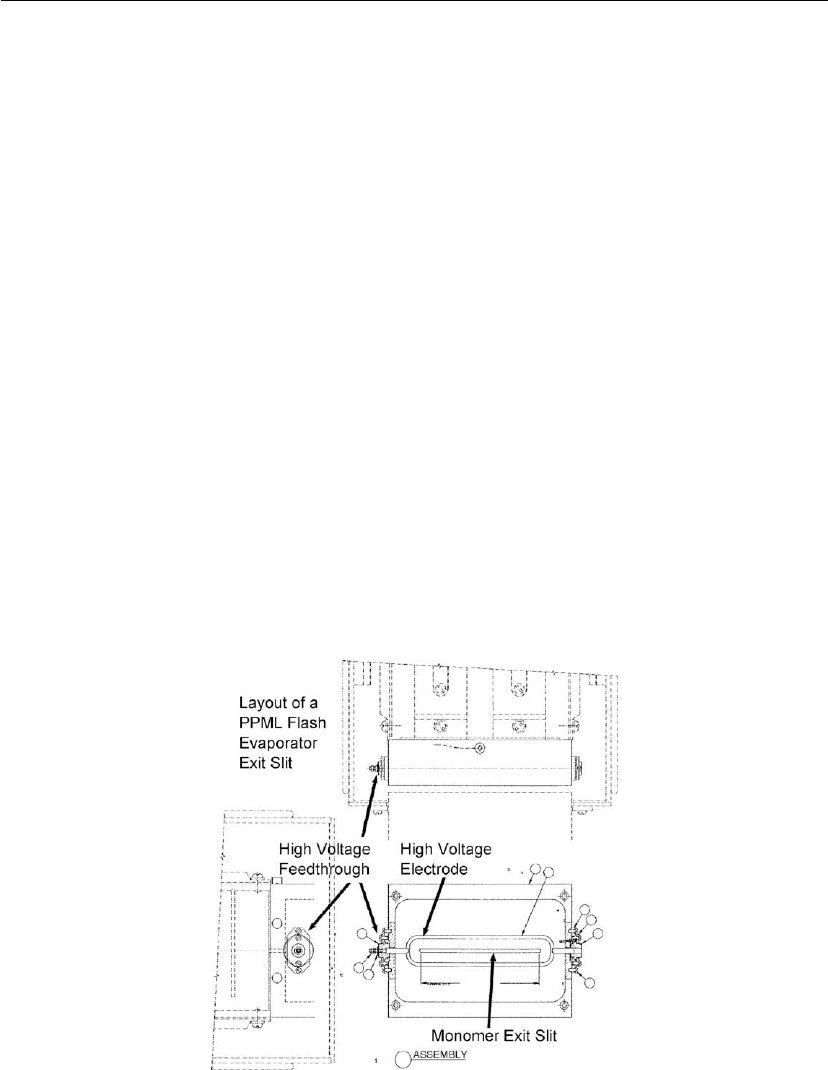
Vacuum Polymer Deposition 541
polymerize to form a solid film owing to the high concentration of radicals and ions contained
in the liquid film.
This process has been successfully implemented in a vacuum roll coating system using a
roll-to-roll deposition process. Polymer films, molecularly doped polymer (MDP) composite
films of polymers containing light emitting organic molecules, and MDP composite films of
polymer containing organic dye molecules have been deposited at thicknesses ranging from
0.1 to 24 m at web speeds as high as 96 linear meters per minute (lin. m/min). Figure 11.2
depicts a modified monomer exit slit that was installed in place of the conventional monomer
exit slit of the standard VPD evaporator shown in Figure 11.1. This modified monomer exit slit
creates a cavity between the monomer exit slit and the drum/substrate. Within this cavity is a
high-voltage electrode, circumferential to the slit, lying between the drum/substrate and the
monomer exit slit. Monomer gas exiting the evaporator becomes the support media for a glow
discharge that is formed by biasing the high-voltage electrode. At a given bias voltage, the
glow discharge current is a function of the monomer gas pressure in the electrode cavity
between the drum/substrate and the monomer exit slit. The monomer pressure, in turn, is a
function of the gap between the drum/substrate and the open face of the cavity, the flow rate of
liquid monomer into the flash evaporator, and the flow of ballast gas (inert Ar or a reactive
mixture) into the flash evaporator. A ballast gas is used when:
the gap and liquid monomer flow rate are not sufficient to provide enough gas pressure
to sustain a steady-state glow discharge, or
Figure 11.2: Modified monomer exit slit that was installed in place of the conventional monomer
exit slit of the standard VPD evaporator.

542 Chapter 11
a specific physical, or chemical, reaction of the ballast gas with the monomer gas is
desired.
PPML deposition, in systems similar to Figure 11.2, can be accomplished with a variety of
bias voltage frequencies (direct current, mid-frequency, and radio frequency).
The following experiments were performed in a vacuum web coater to test the PPML process,
and compare the results with conventional VPD. For a series of monomer flow rates between
0.125 and 0.625 ml/s the web was run for intervals at a series of line speeds between 0.5 and
96 m/min. Conductance calculations give estimates of the pressure in the electrode cavity
shown in Figure 11.2 as ∼ 0.02 torr for monomer flows of 0.125 ml/s and 0.1 torr for monomer
flows of 0.625 ml/s. Each of the constant monomer flow/constant web speed intervals was
further divided into three segments in which different cure mechanisms were used to
polymerize the condensed monomer: UV cure, e-beam cure, and plasma cure. For these
experiments, TRPGDA monomer was diluted with 5% Ezacure TZT photoinitiator
(2,4,6-trimethylbenzophenone 4-methylbenzophenone). In experiments performed without
photoinitiator added to the monomer and without UV cure segments, PPML films had the
same physical properties as PPML films produced with photoinitiator in the monomer. During
PPML cure segments, the glow discharge voltage was varied between 1 and 3 kV. The
appearance of the deposited films was recorded as deposition proceeded.
Film thickness was measured after the deposition experiments. As a rough measure of the
degree of polymerization, infrared spectral measurements were also made to determine
whether residual acrylate C
C double bonds were detectable.
During the deposition experiments with TRPGDA monomers, UV- and e-beam-cured VPD
layers appeared perfectly clear and transparent. At low plasma cure powers (normalized to unit
flow rate of monomer), generally below about 600 W/ml/min of monomer, the PPML films
also appeared clear during the deposition. At higher power levels, generally above
600 W/ml/min of monomer, however, PPML films appeared hazy during deposition.
Preliminary optical microscope observations indicated that significant polymerization
occurred in the gas phase at higher plasma powers, and that the resultant polymer ‘snows’ out
along with the cryocondensed plasma.
11.3.1.1 Important PPML Points
The PPML process can thus be summarized as follows:
The gas resulting from the flash evaporation of a relatively high molecular weight/low
vapor pressure liquid monomer mixture or from suspensions of insoluble particles in
liquid monomer can be used as the support medium for a glow discharge in a
PECVD-like vacuum deposition process. Deposition rates are orders of magnitude
higher than in conventional plasma polymerization or PECVD processes. This high

Vacuum Polymer Deposition 543
deposition rate is due to cryocondensation of the monomer plasma onto the substrate
as a liquid film that is already charged with radicals as the dominant condensation
mechanism. This condensation process is found to proceed at ambient and higher
substrate temperatures. Upon condensation, the liquefied plasma immediately begins
to polymerize to form a solid film owing to the high concentration of radicals and ions
contained in the liquid film.
The PPML process does not appear to have any depth of cure limitations as with
conventional e-beam-cured VPD films thicker than 2–3 m or conventional UV-cured
VPD films with highly UV absorbing monomers.
The process has been successfully implemented in a roll-to-roll deposition process in a
vacuum roll coating system. Polymer films, and molecularly doped polymer composite
films of polymer and light-emitting organic molecules, have been deposited at
thicknesses ranging from about 0.1 to 24 m at web speeds between 96 and
0.5 lin. m/min.
Since any molecule can form radicals in a plasma, the PPML process is adaptable to
more applications than the acrylate/methacrylate dominated chemistry of the standard
UV- or e-beam-cured VPD processes, but plasma power levels must be closely
monitored.
11.3.2 Extrusion Process Liquid Multilayer Process
It is often necessary to molecularly dope a polymer film with an insoluble solid to increase its
functionality [5, 6]. The liquid multilayer (LML) process starts with a degassed polymer slurry
containing micrometer and nano-size particles of the solid and extrudes this slurry onto a
substrate [2, 5, 6]. This slurry is subsequently cross-linked as discussed above to form a
molecularly doped polymer. With the LML method the particle sizes of the insoluble material
in the final polymer film layer are the same as those of the initial particles that were slurried
with the liquid. The lower limit on LML layer thickness is on the order of 5–15 m, and is
highly dependent on viscosity, while VPD layer thickness can be less than 100
˚
A. Both VPD
and LML processes are compatible with simultaneous, in-line, deposition by conventional
vacuum coating processes described previously, such as sputtering, evaporation, or PECVD.
The vacuum roll coater depicted in Figure 11.3 routinely integrates both VPD and LML
processes with these conventional coatings.
Examples of molecular dopants that promote hole transport includes metal (8-quinolinolato)
chelates, quinacridone derivatives, and triaryl amine derivatives. Metal (8-quinolinolato)
chelates are used to dope electron transport layers in molecular electronic devices [2]. Typical
monomers include simple acrylate molecules such as polymethylmethacrylate,
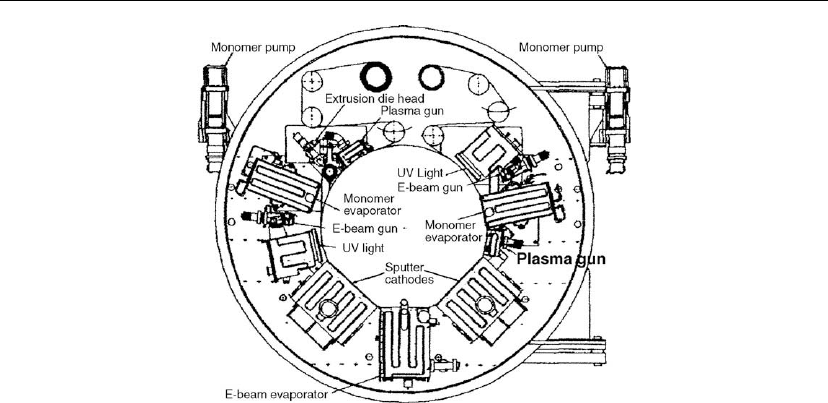
544 Chapter 11
Figure 11.3: Vacuum roll coater with VPD and PVD stations, showing placement of monomer
evaporator, plasma treatment, sputtering cathodes, and electron beam evaporator around the
central drum of a web coater.
hexanedioldiacrylate, and tetraethyleneglycoldiacrylate; styrene and methyl styrene, and
combinations of these precursors. The molecular weight of monomers is generally less than
1000, while for fluorinated monomers it is generally less than 2000. Monomers may be
combined to form oligomers and resins for the polymer matrix, but these materials do not
combine to form other monomers.
11.4 Surface Morphology
Virtually every PVD- or CVD-related process replicates the surface morphology of the
substrate. Polymer films deposited by the VPD process actually smooth the substrate, as
shown in Figure 11.4 [1]. This is demonstrated by the scanning electron micrograph (SEM)
photographs that show the surface of virgin polyester, and the same surface with a 250
˚
A-thick
sputtered Ta coating and a 1 m thick VPD layer. VPD coatings routinely exhibit RMS surface
roughness < 0.1 nm (see Table 11.1).
As presented earlier, a web substrate can be subjected to plasma pretreatment before polymer
deposition to activate the surface and improve adhesion, or to improve adhesion of subsequent
layers [2]. Figure 11.5 shows RMS surface roughness of PET surfaces subjected to Ar, N
2
, and
O
2
plasmas, and the last column in Table 11.1 shows RMS surface roughness resulting from
plasma and e-beam treatment. PET is a linear chain polymer, whereas VPD films are
cross-linked. Referring to Table 11.1, surface treatments of the linear-chain polymer PET
cause much stronger effects on its surface topography and composition than treatment of the
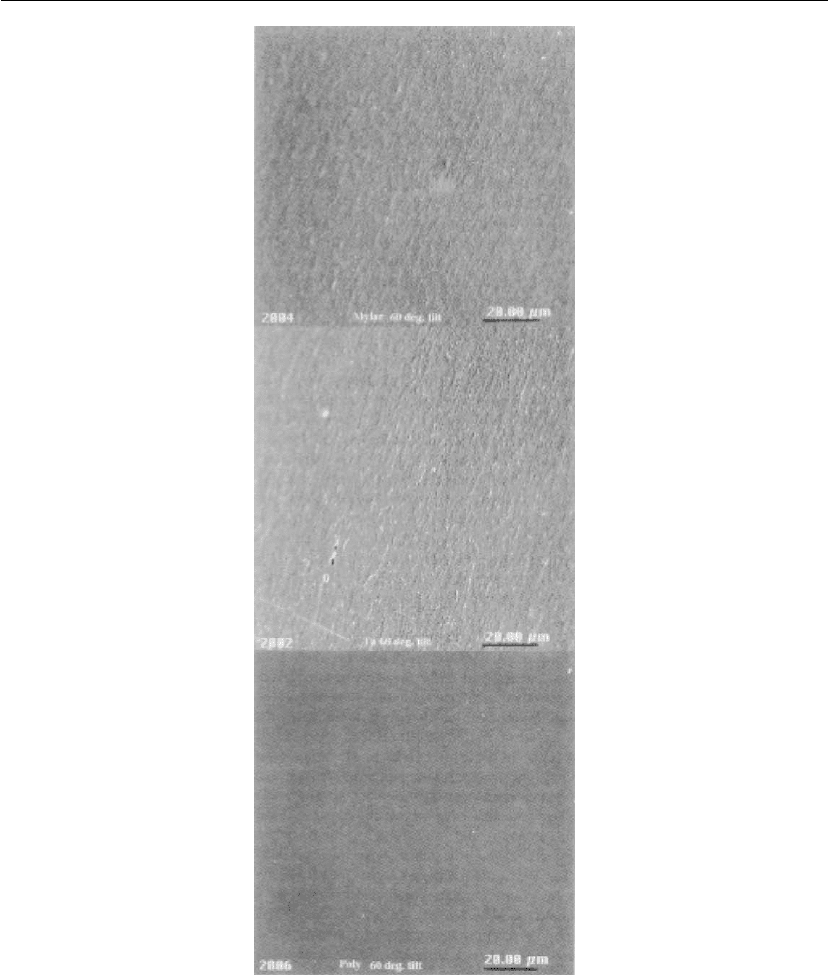
Vacuum Polymer Deposition 545
Figure 11.4: SEM picture of virgin, Ta- and VPD-coated polyester [1].
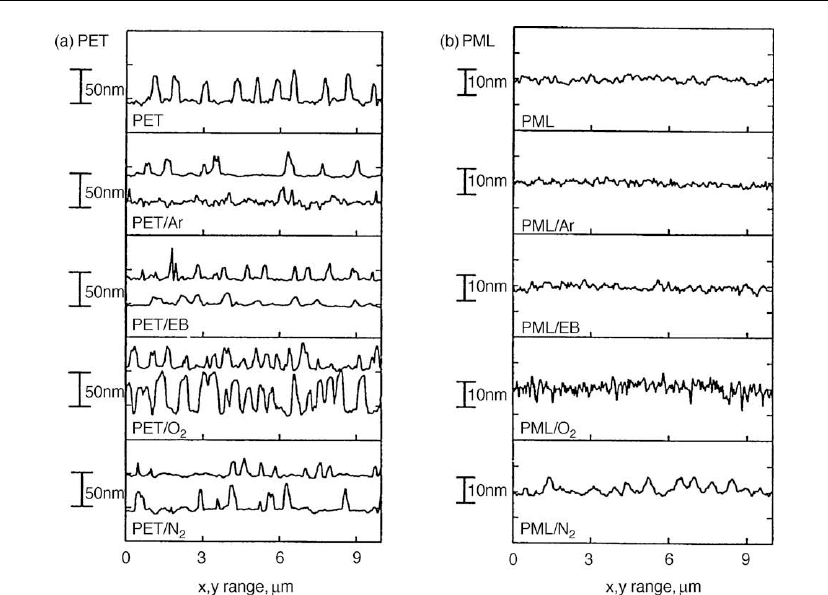
546 Chapter 11
Figure 11.5: RMS surface roughness of PET surfaces subjected to Ar, N
2
, and O
2
plasmas [2].
highly cross-linked VPD surface. Reactive gases like O
2
and N
2
were found to have a
substantially higher impact on the surface topography and roughness of both PET and VPD
when compared to treatments using inert gases such as Ar. Oxygen plasma, however, also
noticeably changes the elemental composition of the VPD surface (see third column), and is
preferred for adhesion improvement. It was also found that high-intensity e-beam corona
treatments could interfere with adhesion of metals, metal-oxides, and polar polymers.
11.5 Multilayer Coatings
The versatility of the VPD process is demonstrated by the fact that virtually any PVD or
vacuum deposition process can be used in conjunction with it to produce multilayer coatings,
including magnetron sputtering, and electron and thermal evaporation. Applications for the
VPD process include:
ultrabarrier materials [1, 7]
thin film Li-polymer batteries [8]

Vacuum Polymer Deposition 547
thin film photovoltaics [8]
light-emitting polymers [2]
multilayer optical coatings on flexible substrates [9]
wear- and abrasion-resistant coatings [10]
nanolaminate structures [11]
thin film solar cells [12]
thin film capacitors [1]
electroluminescent devices [2]
radiation detectors
contaminant resistance for fibers/fabrics [13]
corrosion protection [13]
antibacterial coatings [13].
For deposition of multilayer polymer/inorganic coatings, Figure 11.3 shows placement of the
monomer evaporator, plasma treatment, sputtering cathodes, and e-beam evaporator around
the central drum of a web coater. PECVD can also be integrated into this configuration. An
in-line coater with the same features is shown in Figure 11.6. Since VPD processes require a
higher chamber pressure, differential vacuum enclosures are required for PVD processes that
operate at lower pressures. Enclosures operate at pressures required for magnetron sputtering
(2–5 mtorr) or evaporation (e-beam and thermal). Although it would be beneficial to have
enclosures to help certain polymer, the interior of some in-line machines is at the same
Figure 11.6: In-line VPD process (courtesy of Vitex Systems).

548 Chapter 11
pressure with no enclosures required. Reactive gases can also be introduced into the enclosure
for reactive sputtering. This process is used in roll-to-roll, in-line, or batch planetary substrate
configurations.
This process is not limited to conventional single or multilayer structures. The polymer can be
molecularly doped to increase its functionality [2]. Insoluble solids can be suspended in
acrylate polymers. Active, luminescent QuinAcridone (QA) MDP can be produced which
allows fabrication of light-emitting electrochemical cells, light-emitting polymers, and
light-emitting organic diodes.
The general deposition sequence, which can be repeated sequentially, for a multilayer coating
is as follows (around central drum in Figure 11.4):
Plasma surface activation;
Flash evaporate monomer;
UV cure (smoothing layer);
Deposit inorganic (oxide, nitride, metal) layer;
Flash evaporate monomer;
UV cure;
Deposit inorganic layer.
This process is repeated until the requisite number of layers is deposited. Magnetron sputtering
is generally preferred for deposition of the inorganic layer because films are denser than
evaporated materials. However, if a very high rate is required, evaporation and PECVD may be
the only options.
11.5.1 Ultrabarrier Coating
One of the most successful applications for this hybrid process is development and marketing
of transparent ultrabarrier coatings for protection of atmospheric sensitive devices and
materials. In addition, this work has spawned an entire new field of thin film materials
[1, 8–13]. Transparent ultrabarrier coatings are needed to protect molecular electronics
(e.g. organic light-emitting diodes (OLEDs)), thin film solar cells and thin film batteries from
degradation due to water vapor and oxygen permeation. The basic structure of these coatings
consists of alternating layers of polymer/oxide, polymer/metal or polymer/nitride, shown in
Figure 11.7. The coatings are also deposited onto PET, other flexible polymers and plastics to
reduce the water vapor transmission rate (WVTR) and oxygen transmission rate (OTR) by as
much as six orders of magnitude. PET coated with the ultrabarrier coating is known as
Flexible Glass
TM
. The polymer layer creates an ultrasmooth, defect-free surface for deposition

Vacuum Polymer Deposition 549
Figure 11.7: Layer structure of ultrabarrier coating.
of the low-permeation oxide, nitride, or metal layer. A UV cure is generally preferred for
smoothing since an e-beam cure can increase surface roughness (see Table 11.1).
Figure 11.8 shows how the ultrabarrier coating is used to encapsulate an OLED [14]. OLEDs
require a barrier protection ∼ 10
−6
g/m
2
/d for water. If the OLED is on a flexible PET substrate,
both sides of the OLED must be protected, which requires application of the ultrabarrier
coating on the PET as well as over the OLED. Test results show that a 6-layer acrylate/Al
2
O
3
ultrabarrier coating extends the performance of an OLED by at least 10,000 h [14].
Figure 11.8 shows two methods for encapsulation of a thin film solar cell, depending on which
side is exposed to light or for an OLED must emit visible radiation [14]. The ultrabarrier
Figure 11.8: Ultr abarrier coating encapsulation of an OLED [14].
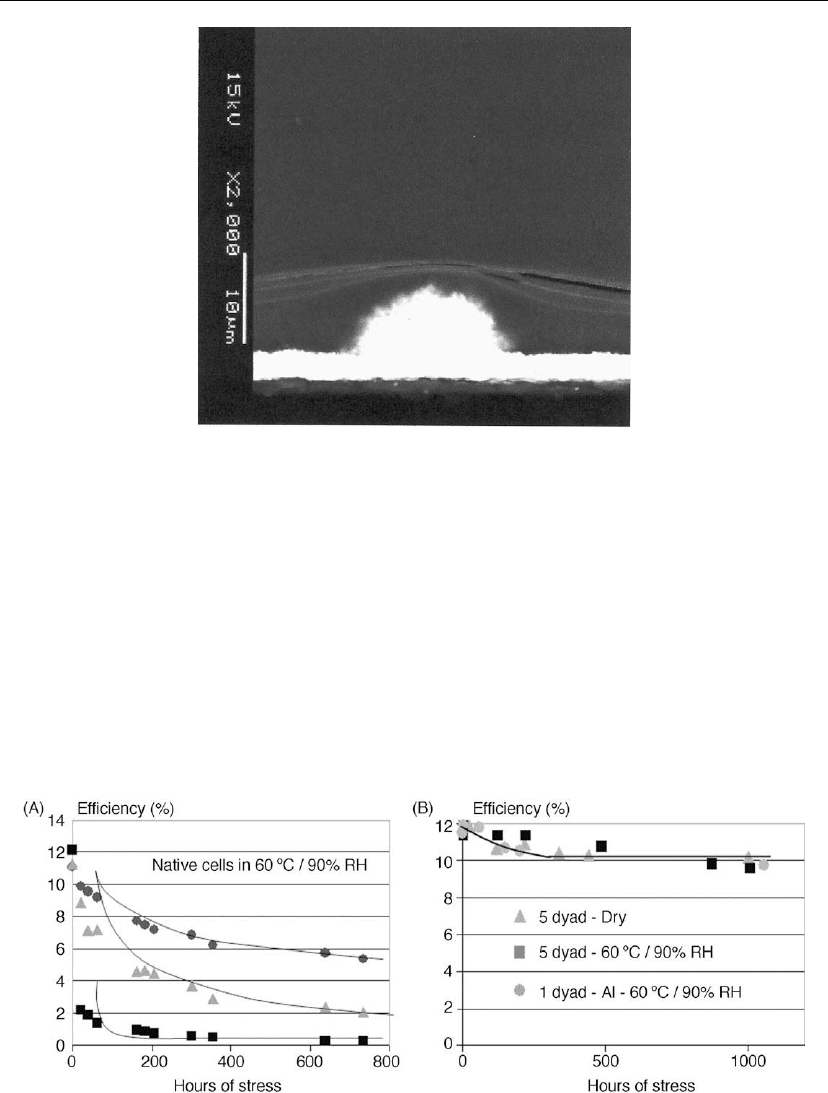
550 Chapter 11
Figure 11.9: Encapsulation of solar cell nodule with ultrabarrier coating [12].
coating can encapsulate a structure significantly higher than the coating is thick, as apparent
in Figure 11.9. Here a 0.5 m thick VPD coating planarizes a 12 m nodule of a thin film
solar cell.
Figure 11.10 shows significant improvement in CdTe solar cell lifetime with application of the
ultrabarrier coating [12]. Figure 11.10(A) shows the performance of a native (unprotected)
cell, while Figure 11.10(B) shows the performance of a protected cell. After a short burn-in
period, the efficiency of the protected cell does not degrade after 1000 h of testing. Ultrabarrier
coatings have excellent optical (and very poor O
2
and H
2
O) transmission, as demonstrated in
Figure 11.10: Efficiency vs hours of stress for native and protected CdTe solar cells [12].
